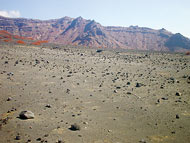2.Nakadake Geosite

Sense the activity of the earth through and active volcano.
After Aso Caldera was formed, a number of volcanos – most of them stratovolcanos – rose inside it, comprising the central cone group. In contrast to the desolate scenery immediately surrounding the crater, an enchanting landscape of meadows and plantation forests covers the volcano's slopes and foothills.
Mt. Nakadake stands in the approximate center of the central cone group. One of the few volcanos in the world where observers can peer directly inside the crater, the mountain attracts a constant stream of tourists. The compound crater is aligned approximately north to south, measuring 900 m in that direction and 400 m east to west. Ancient documents and observations over the past 100 years reveal that volcanic activity shifts over time between seven craters arranged in a line. In the late 1800s the first crater was active, while from 1923 to 1930 the fourth was. Activity then shifted back to the first crater in September 1932 and has remained there since.
Inside the crater is a lake formed during periods of relative calm. With strongly acidic, emerald green water that typically ranges from 50 to 60 degrees Celsius, Nakadake's crater lake is a highlight of the geopark. It receives over a million visitors each year.

Nakadake Crater
The central tourist attraction of Aso Volcano, Nakadake Crater offers a rare glimpse inside an active volcano. Over the past 1,000 years, volcanic ash eruptions have been the primary form of activity at the volcano, with magmatophreatic explosions and Strombolian eruptions during active periods, and fumarolic activity and processes related to the formation of the crater lake occurring during quiet periods.

Sunasenri-ga-hama
Formed several thousand years ago, Sunasenri-ga-hama is the crater basin of Nakadake's younger volcanic edifice. The area is covered in black sand and fine powder from the scoria cone. Visitors will also notice alluvial deposits originating in the dissection of pyroclastic cones, including volcanic projectiles and abundant volcanic cinder. A few plants such as Japanese knotweed also survive in the basin.
